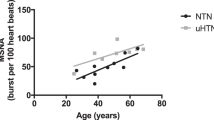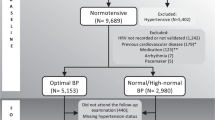Abstract
Laboratory studies in patients with autosomal-dominant hypertension and brachydactyly showed increased sensitivity to sympathetic stimuli and severe abnormalities in baroreflex buffering. To further elucidate the mechanisms by which impaired baroreflex sensitivity could influence blood pressure (BP), we conducted autonomic testing under field conditions. We studied 17 hypertensive affected (13 to 48 years, BMI 22.7 ± 6.5 kg/m2, 160 ± 23/98 ± 15 mm Hg) and 12 normotensive non-affected (9 to 60 years, BMI 24.0 ± 4.7 kg/m2, 120 ± 16/70 ± 10 mm Hg) family members. Pulse intervals and finger BP were measured using the Portapres device. Valsalva ratio, the blood pressure overshoot during phase IV of the Valsalva manoeuver, the Ewing coefficient (RR30/15 ratio), and heart rate and BP variability were similar in affected and non-affected family members. Overall, baroreflex sensitivity calculated using the cross-spectral (BRSLF, BRSHF) and sequence techniques (BRS+, BRS−) was not different between the groups. However, in younger family members, BRS+ was 12 ± 3.7 and 22 ± 13 msec/mm Hg in affected and in non-affected family members, respectively. The decline in BRS with age and with increasing blood pressure was absent in affected family members. We conclude that autonomic reflex testing conducted under field conditions is not impaired in patients with monogenic hypertension and brachydactyly. However, noninvasive testing showed impaired baroreflex control of heart rate at a young age. The reduced BRS in young family members with moderate arterial hypertension may suggest that the impaired baroreflex function is not secondary to the hypertension but rather a primary abnormality, which aggravates the progression of hypertension.
This is a preview of subscription content, access via your institution
Access options
Subscribe to this journal
Receive 12 digital issues and online access to articles
$119.00 per year
only $9.92 per issue
Buy this article
- Purchase on Springer Link
- Instant access to full article PDF
Prices may be subject to local taxes which are calculated during checkout
Similar content being viewed by others
References
Bilginturan N, Zileli S, Karacadag S, Pirnar T Hereditary brachydactyly associated with hypertension J Med Genet 1973 10 253–259
Schuster H et alSevere autosomal dominant hypertension and brachydactyly in a unique Turkish kindred maps to human chromosome 12 Nat Genet 1996 13 98–100
Naraghi R et alNeurovascular compression at the ventrolateral medulla in autosomal dominant hypertension and brachydactyly Stroke 1997 28 1749–1754
Jannetta PJ et alNeurogenic hypertension: etiology and surgical treatment. II. Observations in an experimental nonhuman primate model Ann Surg 1985 202 253–261
Morimoto S et alPulsatile compression of the rostral ventrolateral medulla in hypertension Hypertension 1997 29 514–518
Jannetta PJ, Segal R, Wolfson SKJ Neurogenic hypertension: etiology and surgical treatment. I. Observations in 53patients Ann Surg 1985 201 391–398
Morimoto S et alNeurovascular compression of the rostral ventrolateral medulla related to essential hypertension Hypertension 1997 30 77–82
Morimoto S et alDecreases in blood pressure and sympathetic nerve activity by microvascular decompression of the rostral ventrolateral medulla in essential hypertension Stroke 1999 30 1707–1710
Baylis PH, Robertson GL Osmotic and non-osmotic stimulation of vasopressin release [proceedings] J Endocrinol 1979 83 39P–40P
Jordan J et alNN-nicotinic blockade as an acute human model of autonomic failure Hypertension 1998 31 1178–1184
Jordan J et alSeverely impaired baroreflex-buffering inpatients with monogenic hypertension and neurovascular contact Circulation 2000 102 2611–2618
Tank J et alReference values of indices of spontaneous baroreceptor reflex sensitivity Am J Hypertens 2000 13 268–275
deBoer RW, Karemaker JM, Strackee J Hemodynamic fluctuations and baroreflex sensitivity in humans: a beat-to-beat model Am J Physiol 1987 253 H680–H689
Guzzetti S et alSympathetic predominance in essential hypertension: a study employing spectral analysis of heart rate variability J Hypertens 1988 6 711–717
Heart rate variability Standards of measurement, physiological interpretation, and clinical use. Task Force of the European Society of Cardiology and the North American Society of Pacing and Electrophysiology Eur Heart J 1996 17 354–381
Tarazi RC, Dustan HP Neurogenic participation in essential and renovascular hypertension assessed by acute ganglionic blockade: correlation with haemodynamic indices and intravascular volume Clin Sci 1973 44 197–212
Shannon JR et alSympathetically mediated hypertension in autonomic failure Circulation 2000 101 2710–2715
Grassi G et alBaroreflex control of sympathetic nerve activity in essential and secondary hypertension Hypertension 1998 31 68–72
Shannon JR et alUncoupling of the baroreflex by NN-cholinergic blockade in dissecting the components of cardiovascular regulation Hypertension 1998 32 101–107
Weinstock M, Gorodetsky E Comparison of the effects of angiotensin II, losartan, and enalapril on baroreflex control of heart rate in conscious rabbits J Cardiovasc Pharmacol 1995 25 501–507
Acknowledgements
This study was supported by a grant-in-aid from AstraZeneca Co, Wedel, Germany.
Author information
Authors and Affiliations
Rights and permissions
About this article
Cite this article
Tank, J., Toka, O., Toka, H. et al. Autonomic nervous system function in patients with monogenic hypertension and brachydactyly: a field study in north-eastern Turkey. J Hum Hypertens 15, 787–792 (2001). https://doi.org/10.1038/sj.jhh.1001271
Received:
Revised:
Accepted:
Published:
Issue Date:
DOI: https://doi.org/10.1038/sj.jhh.1001271



